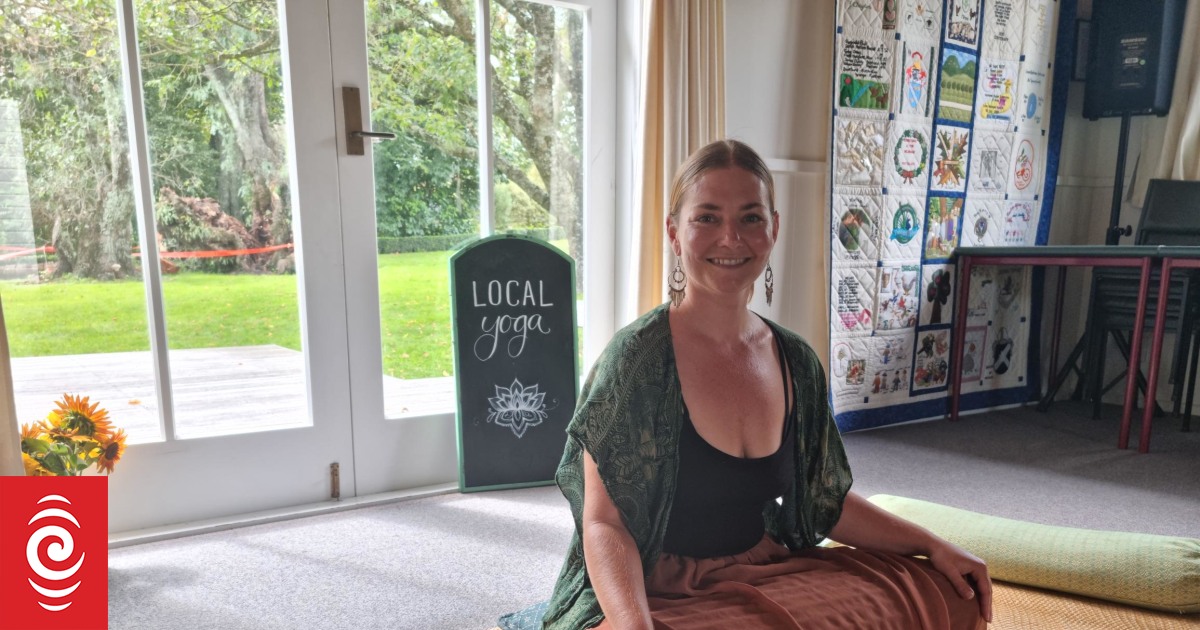Yoga teacher Claire Holmes who lives in Puketapu was without power for three weeks.
Photo: RNZ / Niva Chittock
One month on from Cyclone Gabrielle, some in Hawke’s Bay remain without power. Candle-lit baths, darkened houses or a noisy generator have become the new normal.
But the lights are slowly coming back on. Claire Holmes lives in Puketapu, just down the road from where the Tutaekuri River washed away the bridge to Fernhill. For more than three weeks, her home like many, was without power.
“My circadian rhythms have loved it. I’ve had a great sleep at night because the mahi during the day has been physical and emotional… just a lot,” she said.
“[We were] candle-lit bathing… I was stoked the day we bypassed the heater on the gas and had a hot shower – that was a good day.”
On Saturday, electricity was restored, which was a nice surprise for Ryan Gittings.
He is the assistant manager of an orchard nearby on Dartmoor Road, where almost a kilometre of powerlines were destroyed.
“Pretty stoked that’s underway. Unison and that Horizon company have been just flat-tack, putting powerlines up left, right and centre, and cables up a lot faster than I thought they would – [it has been] a massive effort from them,” he said.

The orchard in Dartmoor Road.
Photo: RNZ / Niva Chittock
Gittings added they now had access to almost every paddock on the 40-hectare block.
“About six hectares are written off… but we’re managing to harvest a little now which is better than we thought a month ago. Back then we didn’t think we would be able to harvest anything.”
It was a hive of activity in the valley, with diggers shifting silt, logs and other debris, clearing tracks for line crews, who were busy reinstating the cables from cherry pickers.
They were working to reconnect the 750 customers still off the mains, like Kay Marsh on Puketitiri Road.
“We’ve got power but we’re on a big genny [generator] that we’re feeding diesel every day. Hopefully soon though we’ll get back on the main track,” she said.
Over the weekend, the region finally began to reinstate its connection to the national grid, Unison incident manager Jason Larkin said.
“We’ve come from 75,000 customers off [the mains network] at the height of the storm down to 750 in less than a month. But we know how hard it is for those 750 customers still without power,” he said.
“Around half of those are what we call residential customers and of those… probably less than 200 are actually occupied houses.”
Staff had been attending crucial community meetings – sometimes flying in by helicopter – to understand the needs of each property and prioritise work.
Generators were set up for those who needed them while permanent repairs were carried out.
Cyclone Gabrielle was far worse than regular storms where maintenance crews were normally just dealing with wind downing branches onto lines.
In this case, there were the added challenges of flooding, silt and whole power poles being ripped out of the ground, Larkin said.
The Awatoto substation in Napier had been particularly difficult because it also had to be tested for contamination.
But with residents now mostly connected, the focus was shifting to commercial properties, he said.
“This week, in Awatoto, we’re looking to provide a limited power supply to businesses and industrial customers. Not enough that they can restart their processes but just enough power that they’re able to do the cleanup on their properties.
“Power for water blasters, for lights so they can actually clean inside their buildings, for water supplies… and things like electric gates and security alarm systems,” Larkin said.
As power was restored and external help began to move out of communities, Holmes believed it was more important for residents to keep checking in with each other.
“I really hope that there are ongoing community hui meetings, even just a monthly something. The way the community really came together… if we can continue that in less of a crisis-point state, to continue checking in, to have a forum and space for our people to have their voices heard… that would be good,” she said.
She was offering free local yoga and mindfulness sessions two doors down in the church hall for anyone who needed it.

Kay Marsh says delivering care boxes is a chance to meet some new people.
Photo: RNZ / Niva Chittock
Meanwhile, Kay Marsh was busy dropping off care boxes.
“This lady came [to our house] and delivered a parcel. So I rang and said ‘what’s this for? Can I help?’ And the next thing I know I’m out delivering parcels,” she said.
“I deliver wherever, [the locals] have it all worked out… I love it, you get to meet new people in the community… people tell you their little stories, it’s very interesting.”
All were certain that while it may be a while yet before the region was back on its feet, the community were banding together to support each other through.




















Discussion about this post